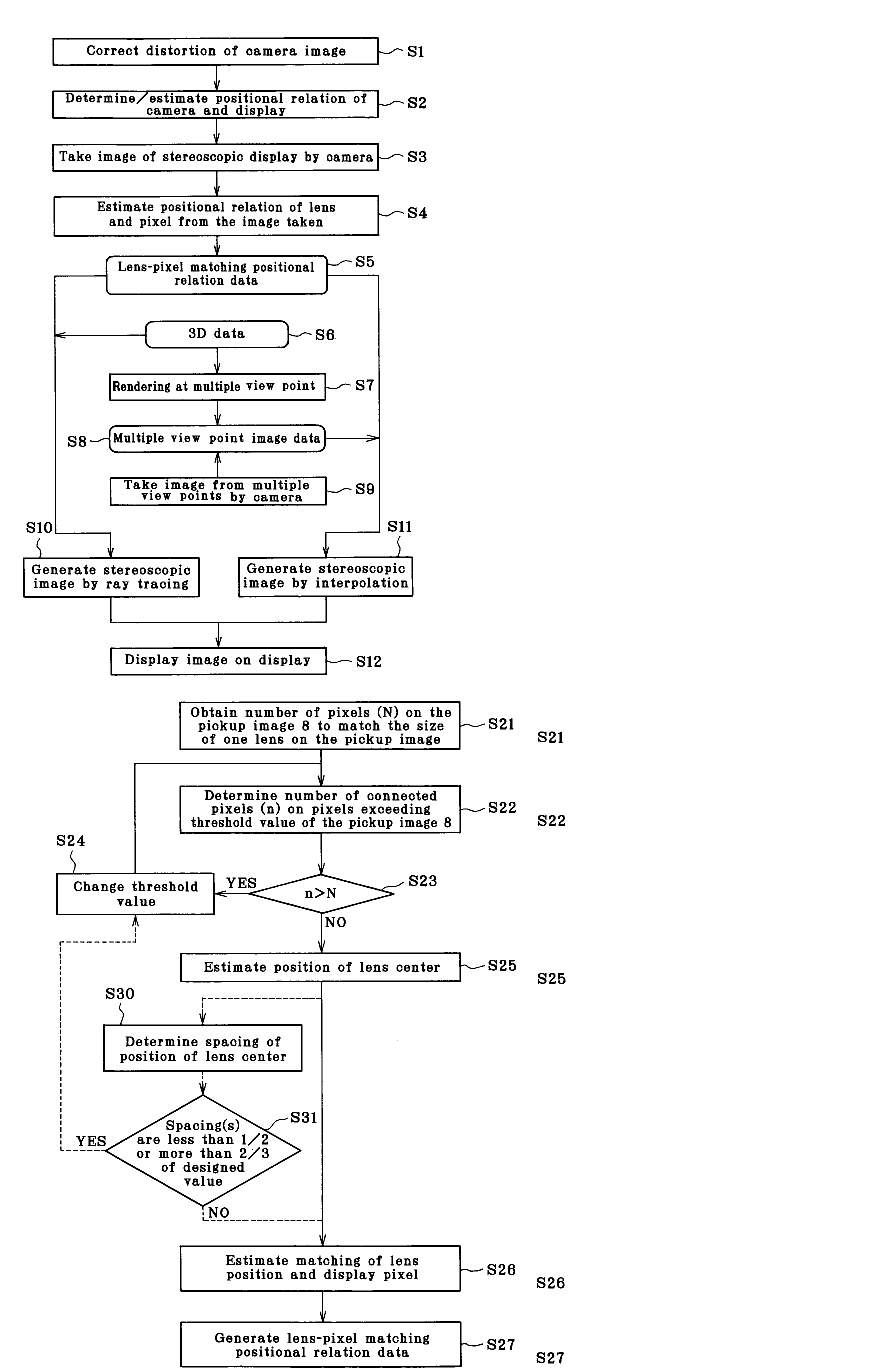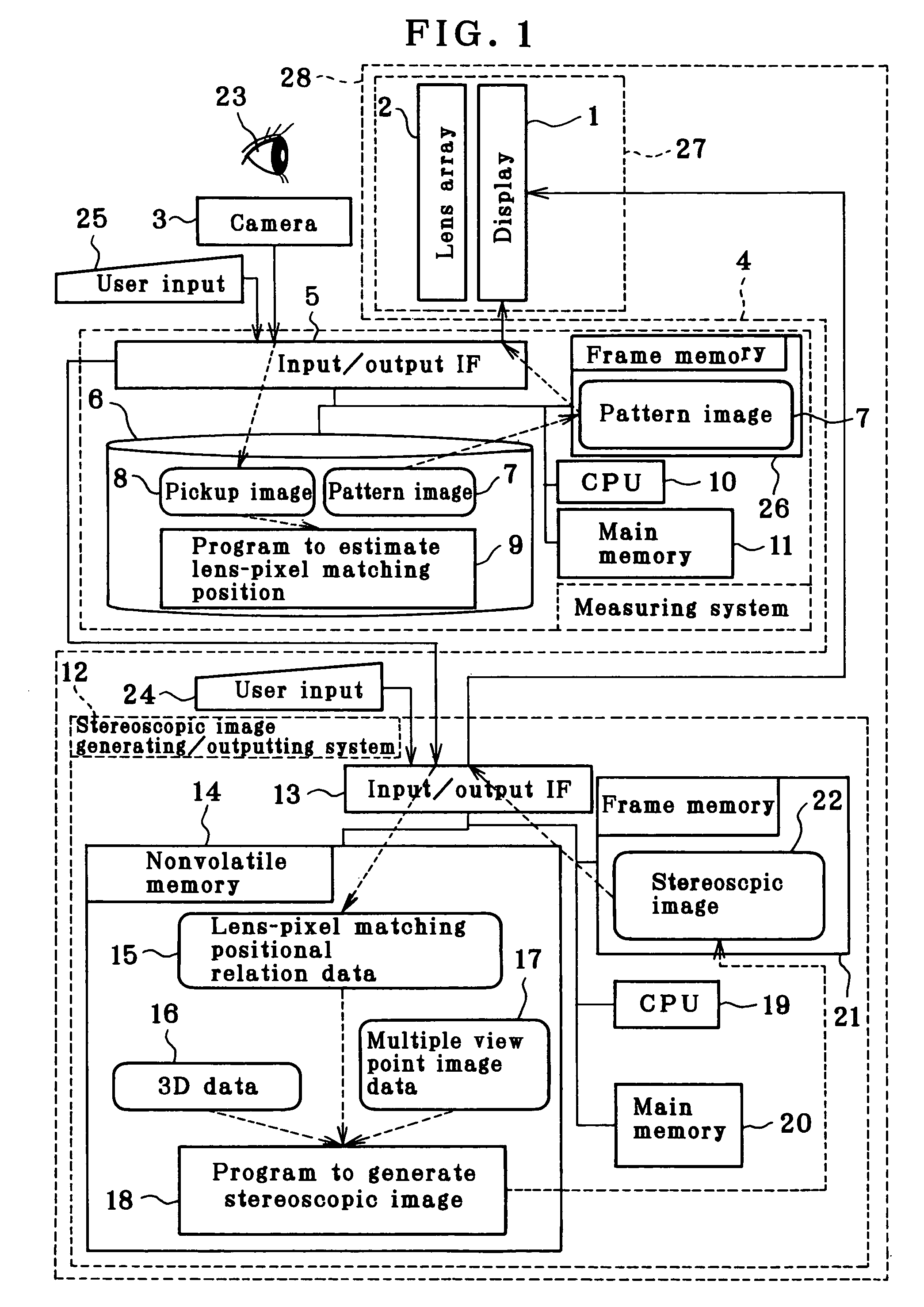Autostereoscopic display
a technology of autostereoscopic display and display screen, which is applied in the field of system for providing a stereoscopic view, to achieve the effects of reducing the accuracy of the lens array, high technical skill, and reducing production costs
- Summary
- Abstract
- Description
- Claims
- Application Information
AI Technical Summary
Benefits of technology
Problems solved by technology
Method used
Image
Examples
embodiment 1
[0035]FIG. 1 is a block diagram of Embodiment 1. In the figure, a dotted arrow mark shows a conceptual data flow. A stereoscopic display 27 is a combination of a display 1 for displaying an ordinary type 2-dimensional image and a convex lens array 2. An observer 23 observes the stereoscopic display 27 from the direction of the convex lens array 2.
[0036]First, relation between lens and pixel on the stereoscopic display 27 is obtained by using a measuring system 4. In a storage unit 6 of the measuring system 4, a pattern image 7 for measurement is stored. In response to an input from a user input unit 25, the pattern image 7 is loaded to a frame memory 26 via OS (operating system), and the pattern image 7 is displayed on the display 1 via an input / output IF (interface).
[0037]A camera 3 is used to take the image displayed on the display 1 via the lens array 2. The image thus taken is stored in the storage unit 6 via the input / output IF 5 as a pickup image 8. Then, a program 9 to estima...
embodiment 2
[0094]As Embodiment 2, description will be given on a case where the multiple viewpoint image data 17 is generated from the 3D data 16 in the flow chart of FIG. 3 and a stereoscopic image is approximately generated.
[0095]The multiple viewpoint image data 17 is prepared by the rendering as an image of two or more viewpoints from the 3D data 16 (Step S7). Description will be given on an embodiment of this rendering referring to FIG. 10. In this embodiment, parallel projections are used by assuming that the viewpoint is at infinity. The projection plane is fixed to facilitate the generation of the stereoscopic image.
[0096]First, in FIG. 10, a projection plane 60 is determined to match with the resolution of the display. Next, based on the 3D data 16, a 3-dimensional object 57 is placed at a position where the stereoscopic display is to be given.
[0097]Parallel rays 63 in projecting direction 62 as designated are defined for each pixel 61 on the projection plane 60. Color and brightness ...
embodiment 3
[0110]As Embodiment 3, description will be given below on a case where the stereoscopic image is generated by approximately using interpolation (Step S11) from the multiple viewpoint image data 17 acquired by image-taking at multiple viewpoints (Step S9) using a multi-camera in the flow chart of FIG. 3 by referring to FIG. 11.
[0111]In order to facilitate the explanation on the image-taking in Step S9 of FIG. 3, description will be given now on a model, in which an object 70 shown in FIG. 11 is taken by two cameras.
[0112]For each of the cameras, distortion is corrected in advance, and it is assumed that the image is taken as perspective projection from the ideal viewpoint. It is assumed that the ideal viewpoint of the camera at a standard camera position is 71 and an optical axis is 79. The projection plane is regarded as 72 from the field angle of the camera, and it is supposed that the surface of the object 70 closer to the ideal viewpoint is projected.
[0113]In contrast to this cam...
PUM
 Login to View More
Login to View More Abstract
Description
Claims
Application Information
 Login to View More
Login to View More - R&D
- Intellectual Property
- Life Sciences
- Materials
- Tech Scout
- Unparalleled Data Quality
- Higher Quality Content
- 60% Fewer Hallucinations
Browse by: Latest US Patents, China's latest patents, Technical Efficacy Thesaurus, Application Domain, Technology Topic, Popular Technical Reports.
© 2025 PatSnap. All rights reserved.Legal|Privacy policy|Modern Slavery Act Transparency Statement|Sitemap|About US| Contact US: help@patsnap.com



